
The Smart Office revolutionizes businesses by creating a more efficient and comfortable workplace. They are designed to make it easier for employees to communicate, collaborate, and get their work done quickly and efficiently. How to reach this? We explain it in this article!
What is a Smart Office?
A Smart Office is a modern environment that uses technology and automation to improve workplace productivity. It utilizes various tools, including automated lighting, temperature control, communications systems, security systems, and interactive touch screens, to create an intelligent workspace that facilitates collaboration, helps employees stay organized, and increases efficiency. Besides utilizing state-of-the-art technology such as voice recognition, artificial intelligence, and cloud computing, intelligent offices help reduce manual labor and improve overall productivity.
Take care of your employees.
Employee well-being should always be top of mind when creating a smart office. Studies have shown that employees with greater job satisfaction and mental health are more productive and engaged in their work. Statistics say that the global smart office market to grow to more than 66 billion U.S. dollars by 2027. It will be growing.
Improve well-being
There are many ways to promote positive mental health in the workplace, including providing access to resources like Employee Assistance Programs (EAPs), counseling services, flexible working hours, and encouraging healthy habits such as regular exercise. Additionally, employers can create a welcoming environment by incorporating amenities like comfortable seating areas for breaks or private spaces for confidential conversations.
Enhance communication
Smart offices also benefit from technology investments that make communication more accessible and efficient. For example, implementing cloud-based software solutions can reduce the need for paper documentation, allowing employees to share information quickly and efficiently. In addition, automated scheduling tools can streamline processes and reduce paperwork, while video conferencing helps teams collaborate without having to be in the same physical space.
Create a working atmosphere.
Finally, employers should consider incorporating natural elements into their office designs to create a calming environment that boosts moods and productivity. Integrating green spaces such as plants, adding natural light where possible, or using materials with organic shapes and textures like wood, stone, or fabric can benefit employees’ well-being.
Is Smart Office about possibilities or control?
A Smart Office gives businesses unprecedented control and the ability to customize their office environment in ways that were not previously possible. Using sensors, automation, and intuitive software, the business owner creates an intelligent office tailored to meet an organization’s specific needs.
Activity monitoring
It could range from controlling lighting and temperature levels to monitoring employee activity or optimizing energy usage. With this level of control, businesses can save money on utilities, increase productivity, and enhance security, all while maintaining maximum employee comfort. Besides, a dedicated software development team developed handy tools to track workers’ activity and see their progress.
For example, they can detect equipment malfunctioning before it becomes a significant issue or alert managers if an unauthorized person is in the building. These features make Smart Offices an invaluable asset to any business looking to increase efficiency, cut costs, and remain competitive in today’s market.
It increases security.
Smart offices also provide enhanced security measures that protect data from unauthorized access or alteration. For example, through facial recognition software and other monitoring systems, businesses can better protect sensitive information from external threats while allowing employees to work safely within the office environment.
Additionally, with access control measures like keyless entry systems and biometric scanners, businesses can ensure that only authorized personnel can access the office and its contents.
When can a business owner make an intelligent office?
A business owner can make a smart office at any time. However, there are certain factors to consider before deciding to do so. First and foremost, investing in technology for a smart office requires financial investment; thus, it is essential to ensure that such an investment can be justified with potential returns. Additionally, the project must be appropriately managed to guarantee success; this means having a clear action plan before moving forward.
Think about dimensions.
Another factor to consider is the office’s size and the complexity of its operations. As a result, different types and levels of technology may need to be implemented to achieve optimal efficiency and productivity. For example, if a business has multiple locations or deals with large amounts of data, investing in more sophisticated systems and tools may be necessary.
Ultimately, whether or not to make an intelligent office will depend on the individual business owner’s needs and budget. However, the rewards can be significant if the investment can be justified and appropriately managed.
Assign a transition manager to create an intelligent office.
The transition manager will work with the organization to develop and implement a plan that outlines how they can transition to a bright office. This plan should include selecting the right technology, preparing the workplace, training employees on how to use the technology, and implementing policies and procedures related to using it.
The transition manager should also be able to provide guidance and support throughout the entire process. Additionally, they should be able to work with other departments within the organization to ensure that all of their needs are met during the transition period. Finally, they should have experience managing large-scale projects and understand how different technologies can integrate into existing systems.
We hope that you can create and get the office of your dreams. Good luck!

Taylor is a freelance SEO copywriter and blogger. His areas of expertise include technology, pop culture, and marketing.
















![The 5 Best Standing Desks on Amazon [Update 2020] The 5 Best Standing Desks on Amazon](https://techsmartest.com/wp-content/uploads/2019/02/71T-Ijlxr7L._SL1500_-100x70.jpg)